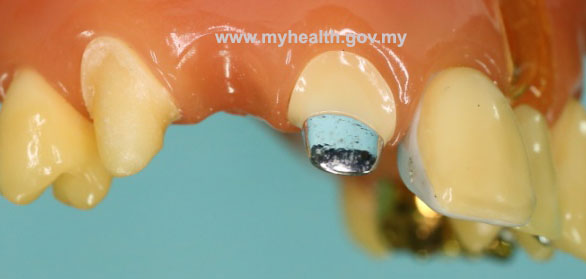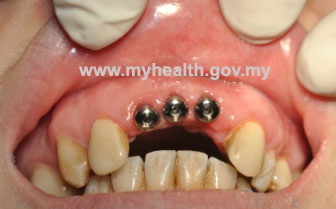Introduction
| Dental implant is one of the treatments that will replace missing tooth/teeth in the jaw. It is a fixed type of prosthesis and its ‘root’ or fixture will fuse to the surrounding bone. There are so many systems available in the market and unfortunately these systems are not interchangeable. Even within the same system there are multiple choices of shapes and sizes. Some fixtures have specially treated surfaces to enhance integration to the bone. The patient’s available bone will eventually determine the selection of a proper dental implant. |
 |
Regardless of the brand, the main basic component of all implant fixtures is that they are made of titanium. This metal is special in the way that it is inert in our body and the bone fuses directly onto its surface (osseointegration) (1).
Alternatives to Dental Implant
- Dental bridge

 3-unit dental bridge
3-unit dental bridge - Denture

 Partial denture – Chrome
Partial denture – Chrome
Full dentures – Acrylic
Why dental implant?
|
Dental implant had undergone so much of improvement since its first practical application in 1965 following successful osseointegration (osseo – bone, integration – fusion) demonstrated by Professor Per-Ingvar Brånemark in 1952 (2). Since then, scientific research has been conducted continuously worldwide to further improve this dental implant clinically until today. Since it is fused to the jawbone, this prosthesis has gained higher acceptance among public despite its cost. This is because psychologically, the patients may feel that this prosthesis is part of them. Functionally, this prosthesis performs much better than conventional type of fixed prosthesis i.e. dental bridge. Placement of dental implant will not disturb adjacent tooth/teeth whereas other fixed dental prostheses usually require cutting or preparation of adjacent tooth/teeth. Removable type of prosthesis, denture tends to be not very retentive. Dental implant can be used as an anchorage for removable prosthesis or denture which gives it good retention. Maintenance wise, dental implant requires much easier way of cleaning as compared to other fixed dental prosthesis as it stands independently from other adjacent teeth; just like an original tooth.
|
 Placement of 3 individual implants. |
|
 Good bone-implant interface. |
||
 Final individual prosthesis. |
||
Factors to consider
Although dental implant outweighs other types of dental prosthesis in many ways, there are factors however determine its long term success. These factors determine whether or not the dental implant is a suitable choice and they range from relative to strict contraindication.
-
General medical illness
Good health is a gold standard for the case selection. Uncontrolled medical illnesses such as diabetes mellitus, hypertension and heart diseases are contraindicated until they are fully controlled. This is because, placement of dental implant requires a surgical procedure in which these diseases may adversely affect the surgical procedure and subsequent wound healing.
Patient with advanced metabolic bone disease such as osteoporosis or osteopetrosis (marble bone disease) may not be a good candidate for this prosthesis. These diseases affect bone healing and are not be able to provide good bone support for the implanted prosthesis. Certain medications such as bisphosphonate group of drugs which are used to treat bone diseases such as osteoporosis, may not favour the insertion of dental implant. This drug is associated with Bisphosphonate Related Osteonecrosis of the Jaw (BRONJ) (3). The implant treatment may be resumed once the medications are discontinued.
Previously irradiated jaw is associated with increased implant failure (4). This is due to poor blood supply to this area post-irradiation. Patients undergoing chemotherapy is not a candidate for dental implant. Patient with bleeding disorder or on anticoagulant therapy must seek their Physician’s advice before proceeding to dental implant insertion (4). Allergy to titanium metal is a strict contraindication to treatment of dental implant.

BRONJ of the left maxilla secondary to treatment with alendronate for osteoporosis.
Courtesy: http://www.hindawi.com/ - Age
Old age on its own is not a contraindication to the treatment (4) but the patient need to be excluded from other diseases especially age related ones. To the other extreme, too young patients are not indicated for the dental implant until their growth is complete.
- Residual alveolar bone ridge
The dimension of the remaining bone and thickness of the gum determines the selection of dental implant. Adequate bone width and height are required for the implant. However, bone dimension can be altered by performing additional surgery such as sinus lift, bone augmentation and distraction osteogenesis before implant insertion. This procedure makes placement of dental implant possible.
- Cost
Cost of dental implant treatment is more than for dentures or simple bridge work. There is another type of implant i.e. mini dental implant which is, as its name suggests, a much smaller size, may cost less. However, this type of implant has a limited range of indications and its use is controversial in some aspects.
- Oral hygiene
Oral hygiene plays a major role in determining the success of the prosthesis. If the oral hygiene is poor, most likely that the implant won’t last as “peri-implantitis” can occur and causes gum inflammation and loss of the surrounding bone. It is therefore essential that the oral hygiene is in good condition before treatment of dental implant is carried out as huge investment is made for the treatment. Ability in maintaining good oral hygiene also must be put into consideration before decision is made for the treatment. Poor manual dexterity patients such as mentally challenged or physically handicapped ones are not a good candidate unless the next of kin can play an effective role.
- Habits
- Smoking
Heavy smoker may not be a good candidate for dental implant and if combined with other risk factors he may have, it may be contraindicated (4).
-
Parafunction habit
Bruxism is an excessive clenching of teeth/ jaw and it predisposes dental implants to failure. Therefore this condition must be treated first or otherwise the implant must be inserted cautiously to an area of relatively low masticatory load.
- Smoking
References
- http://www.osseo.org/NEWwhatIsDentalImplant.html. [Online]
- http://dentalimplants-usa.com/treatment/implants/history.html. [Online]
- http://www.aaoms.org/conditions-and-treatments/bronj/. [Online]
- Mark Ayson, Jonathan Leichter and Karl Lyons. http://www.acc.co.nz/PRD_EXT_CSMP/groups/external_providers/documents/reports_results/wpc090453.pdf. [Online]
| Last Reviewed | : | 7 August 2014 |
| Writer | : | Dr. Alauddin b. Muhamad Husin |
| Accreditor | : | Dr. Kok Tuck Choon |








